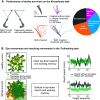Perceptual-Cognitive Integration for Goal-Directed Action in Naturalistic Environments
- PMID: 37940592
- PMCID: PMC10634571
- DOI: 10.1523/JNEUROSCI.1373-23.2023
Perceptual-Cognitive Integration for Goal-Directed Action in Naturalistic Environments
Abstract
Real-world actions require one to simultaneously perceive, think, and act on the surrounding world, requiring the integration of (bottom-up) sensory information and (top-down) cognitive and motor signals. Studying these processes involves the intellectual challenge of cutting across traditional neuroscience silos, and the technical challenge of recording data in uncontrolled natural environments. However, recent advances in techniques, such as neuroimaging, virtual reality, and motion tracking, allow one to address these issues in naturalistic environments for both healthy participants and clinical populations. In this review, we survey six topics in which naturalistic approaches have advanced both our fundamental understanding of brain function and how neurologic deficits influence goal-directed, coordinated action in naturalistic environments. The first part conveys fundamental neuroscience mechanisms related to visuospatial coding for action, adaptive eye-hand coordination, and visuomotor integration for manual interception. The second part discusses applications of such knowledge to neurologic deficits, specifically, steering in the presence of cortical blindness, impact of stroke on visual-proprioceptive integration, and impact of visual search and working memory deficits. This translational approach-extending knowledge from lab to rehab-provides new insights into the complex interplay between perceptual, motor, and cognitive control in naturalistic tasks that are relevant for both basic and clinical research.
Copyright © 2023 the authors.
Figures





References
Publication types
MeSH terms
Grants and funding
LinkOut - more resources
Full Text Sources
Medical
Miscellaneous
